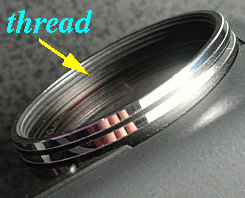
To use filters, we need to know at least two things: thread size and various rings. Look at your lens and you will see a female thread in the inner surface of the lens tube as indicated below. This is the thread for you to mount filters, lens converters and other accessories.

The thread size of a lens is the diameter of this opening. Here are some useful information:
| Lens | Thread Size |
| 950/990/995/4500 on camera lens | 28mm |
| WC-E24 Wide Angle Converter | 48mm |
| WC-E63 Wide Angle Converter | 72mm |
| TC-E2 Tele Converter | 62mm |
| TC-E3ED Tele Converter | 72mm |
Hence, when you buy filters for your 950/990/995/4500, you might first consider filters with thread size 28mm. The following shows a 28mm filter mounted on the on-camera lens. It fits perfectly.
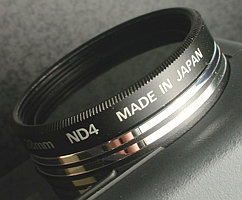
Unfortunately, filters with a thread size of 28mm are not very popular. It is likely that you could only find UV, polarizers, and a number of ND (neutral density) filters. Most commonly used filters start with 37mm thread size. What if the filter you want to use does not have 28mm thread size? Should this happen, you will need step-up rings.
There are three types of "rings": step-up, step-down, and macro coupler that are also referred to as reverse rings. Except for macro couplers, the step-up and step-down rings have one end (with male thread) to be mounted on the camera lens and the other end (with female thread) is used for accepting filters, another ring or other accessories. A ring has two size markings in millimeter such as 28mm-37mm, 49mm-52mm, 77mm-72mm and so on. The first number is the size of the thread that is closer to the camera lens (i.e., the male thread), while the second is the size of the thread of the farther end (i.e., the female thread). Therefore, a step-up ring with marking 43mm-49mm means the male and female thread sizes are 43mm and 49mm, respectively. Similarly, a step-down ring with marking 77mm-72mm means the male and female thread sizes are 77mm and 72mm, respectively.
The first number of a step-up ring is smaller than the second number. Therefore, after mounting a step-up ring, the available (female) thread is larger than the original. The left image below shows three step-up rings: 28mm-37mm, 37mm-49mm and 43mm-49mm. The most commonly used size (among Coolpix users) is the 28mm-37mm that increases the thread size from 28mm (the size of the on-camera lens) to 37mm. Once the thread size is 37mm, many types of filters are available. For example, suppose you have a 37mm enhancing filter and wish to use it on your 950/990/995/4500. What you need is a 28mm-37mm step-up ring. Mount this ring on the on-camera lens and mount the 37mm enhancing filter on this ring as shown in the right image below.
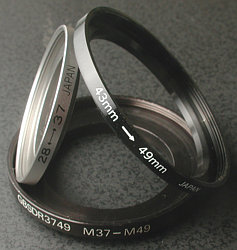
|
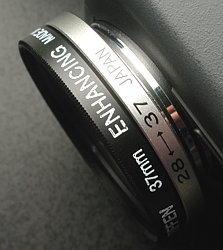
|
You can stack multiple step-up rings together to achieve a larger thread size. For example, suppose you want to use a 49mm fog filter on a 950/990/995/4500. It is unlikely that you can find a 28mm-49mm step-up ring. However, you can use a 28mm-37mm ring and a 37mm-49mm ring as shown in the left image below. Similarly, the WC-E24 wide angle converter has a thread size of 48mm. Although you can mount a 48mm polarizer directly on a WC-E24 (if you can find one), vignetting will occur. To reduce this vignetting problem, you might consider a larger polarizer, say a 72mm one. In this case, you need a 48mm-58mm ring and a 58mm-72mm ring as shown in the right image below. The use of step-up rings going from a smaller thread size to a larger one is usually not unique. The rule of thumb is that use as few rings as possible, and, at the same time, make sure the filter is as close to the lens as possible. Step-up rings are not created equal. Some are considerably thicker than the others. If it is possible, use thinner ones.
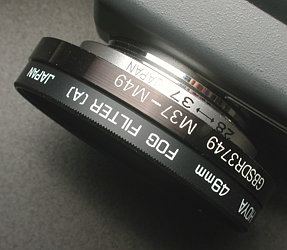
|
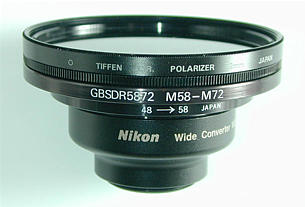
|
Most popular filters have thread sizes at least 46mm or even 49mm. Many people prefer to "standardize" their filters with a single thread size. Hence, 46mm or 49mm, especially the 46mm for Coolpix 5000 shooters, many be the most natural choices. To these users, Nikon's UR-E7 step-up ring (below left) is perhaps the best choice. The UR-E7 goes from 28mm to 46mm directly. Compared with a typical setup that goes from 28mm to 37mm and then from 37mm to 46mm, the UR-E7 is thinner (below right) and easier to handle. If a 49mm filter is needed, one only needs two step-up rings (i.e., UR-E7 followed by a 46mm-49mm) which still is thinner than 28-37 plus 37-49.
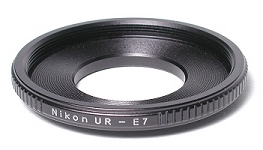
|
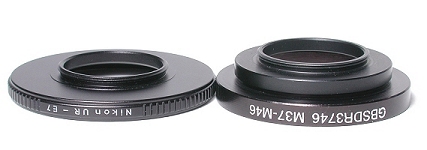
|
On the other hand, a step-down ring has the male thread size larger than the female thread size as shown in the left image below. Thus, mounting a step-down ring on a lens (or another ring) reduces the thread size. In the right image below, a 62mm-52mm step-down ring is mounted on a TC-E2 2x tele converter, reducing the thread size (of TC-E2) from 62mm to 52mm. It is clear that the opening is smaller.
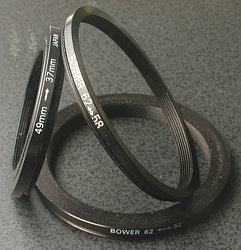
|
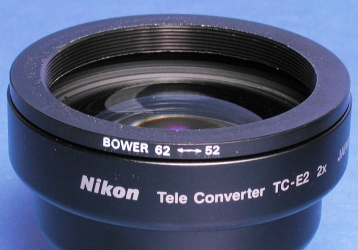
|
Normally, the use of step-down rings is not for mounting filters, but for other accessories. For example, many Coolpix users mount two tele converters together to create a converter of higher power. The left image below shows mounting a tele converter of 52mm thread on a 62mm-52mm step-down ring, which, in turn, is mounted on a Nikon TC-E2. Since both converters are of 2x type, the combo is a 4x tele converter. We can also use multiple step-down rings to reduce the thread size to the one we wish to use. The right image below shows the way of connecting a CrystalVue Sharp Shooter 8x monoscope to a Nikon TC-E2 2x tele converter. Since the former has a 37mm thread, we need a 62mm-52mm step-down ring to reduce the thread size to 52mm, and a 52mm-37mm step-down ring to further reduce the thread size to 37mm. In this way, the combined lens is a 8×2 = 16x tele converter. Unfortunately serious vignetting will occur. The use of step-down rings going from a larger thread size to a smaller one is usually not unique. The rule of thumb is that use as few rings as possible, and, at the same time, make sure the mounted accessory is as close to the lens as possible. Step-down rings are not created equal. Some are considerably thicker than the others. If it is possible, use thinner ones. Click here for more examples.
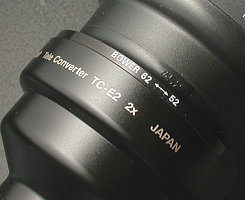
|
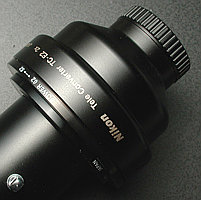
|
Finally, both threads of a macro coupler or a reverse ring are all of male type as shown in the left image below. Because of this fact, macro couplers are not used for mounting filters. Instead, they are frequently used to connect two lenses. More precisely, each male thread is mounted on the filter thread of a lens, and, consequently, these lenses are reversely mounted. The right image below shows that a Nikon TC-E2 tele converter and a Nikon 55mm Micro lens are mounted together reversely. Since the Nikon 55mm Micro lens has a thread size of 52mm and the TC-E2's size is 62mm, a 62mm-52mm step-down ring is mounted on TC-E2, and a 52mm-52mm macro coupler is used to connect the step-down ring and the Nikon 55mm Micro lens. Why are macro coupler needed? In general, when a lens is reversely mounted, magnification is increased. For example, if the prime lens has a focal length of xmm and the reversely mounted lens has a focal length of ymm, then the combined lens will have a magnification of x/y. Since the maximum combined focal length is when a TC-E2 is mounted on a 990 (resp., 995) is 2 × 24 = 48 mm (resp., 2 × 32=64 mm), the magnification factor of the combo is 48/55 = 0.87 (resp., 64/55 = 1.16). Click here to learn more.
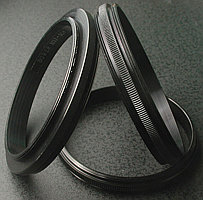
|
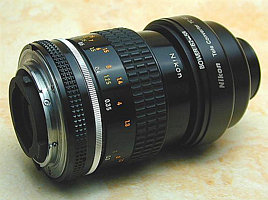
|
What if a filter is required for the reversed lens? The solution is Nikon's BR-3 adapter. One end of the BR-3 adapter (below left) has a 52mm filter thread and the other end can be attached to the lens mounting flange. Note that the BR-3 can only be used with Nikon SLR lenses. The middle image below shows the result of mounting a BR-3 to a Nikon lens. Once it is mounted, a filter can be attached to the 52mm thread (below right).
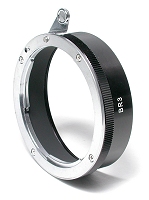
|
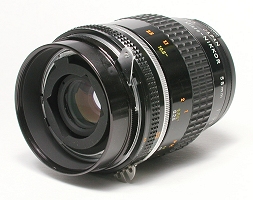
|
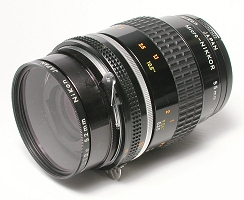
|